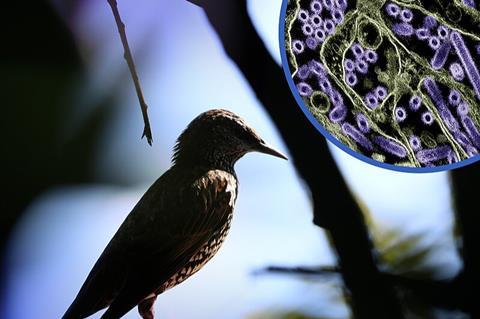Avian influenza viruses typically require several mutations to adapt and spread among humans, but what happens when just one change can increase the risk of becoming a pandemic virus?

A recent study led by scientists at Scripps Research reveals that a single mutation in the H5N1 bird flu virus that has recently infected dairy cows in the U.S. could enhance the virus’ ability to attach to human cells, potentially increasing the risk of passing from person to person. The findings—published in Science on December 5, 2024—highlight the need to monitor H5N1’s evolution.
Currently, there are no documented cases of H5N1 transmitting between people: bird flu cases in humans have been linked to close contact with contaminated environments as well as infected birds (including poultry), dairy cows and other animals.
However, public health officials are concerned about the potential for the virus to evolve to transmit efficiently between humans, which could lead to a new, potentially deadly pandemic.
Attaching to a host
The flu virus attaches to its host via a protein called hemagglutinin that binds to glycan receptors on the surfaces of host cells. Glycans are chains of sugar molecules on cell surface proteins that can act as binding sites for some viruses. Avian (bird) influenza viruses like H5N1 primarily infect hosts with sialic acid-containing glycan receptors found in birds (avian-type receptors). While the viruses rarely adapt to humans, if they evolve to recognize sialylated glycan receptors found in people (human-type receptors), they could gain the ability to infect and possibly transmit between humans.
READ MORE: Bovine H5N1 influenza from infected worker transmissible and lethal in animal models
READ MORE: Key influenza-severity risk factor found hiding in plain sight on our antibodies
“Monitoring changes in receptor specificity (the way a virus recognizes host cells) is crucial because receptor binding is a key step toward transmissibility,” says Ian Wilson, DPhil, co-senior author and the Hansen Professor of Structural Biology at Scripps Research. “That being said, receptor mutations alone don’t guarantee that the virus will transmit between humans.”
Single amino acid mutation
Past cases in which avian viruses adapted to infect and transmit between people required multiple mutations, usually at least three. But for the H5N1 2.3.4.4b strain (A/Texas/37/2024) isolated from the first human infection with a bovine H5N1 virus in the United States, researchers found that just a single amino acid mutation in the hemagglutinin could switch specificity to binding human-type receptors. Here, bovine refers to the species for dairy cows that were the immediate source of the virus for the human infection. Importantly, the mutation wasn’t introduced into the whole virus—only the hemagglutinin protein to study its receptor-binding properties.
For their study, the research team introduced several mutations into the H5N1 2.3.4.4b hemagglutinin protein that had been involved in receptor specificity changes in previous avian viruses. These mutations were selected to mimic genetic changes that could occur naturally. When the team assessed the impact of one of these mutations, Q226L, on the virus’ ability to bind to human-type receptors, they found that that mutation significantly improved how the virus attached to glycan receptors, which represent those found in human cells.
“The findings demonstrate how easily this virus could evolve to recognize human-type receptors,” says first author Ting-Hui Lin, a postdoctoral associate at Scripps Research. “However, our study doesn’t suggest that such evolution has occurred or that the current H5N1 virus with only this mutation would be transmissible between humans.”
How mutations arise
Instead, the research team focused on understanding how natural mutations, like Q226L, could arise and what their impact might be. To investigate the potential mutations that could enable the H5N1 2.3.4.4b hemagglutinin to attach to human receptors, the team used advanced binding assays in collaboration with the lab of co-senior author James Paulson, PhD, the Cecil H. and Ida M. Green Chair of Chemistry at Scripps Research. These assays, which are tests to mimic how well a virus attaches to a cell, allowed the researchers to precisely track how the altered H5N1 hemagglutinin interacted with human-type receptors.
“Our experiments revealed that the Q226L mutation could significantly increase the virus’ ability to target and attach to human-type receptors,” explains Paulson. “This mutation gives the virus a foothold on human cells that it didn’t have before, which is why this finding is a red flag for possible adaptation to people.”
Human-to-human transmission
The shift alone, however, may not be enough to enable human-to-human transmission. Other genetic changes—such as mutations in polymerase basic 2 (E627K) that enhance viral replication and stability in human cells—would likely be necessary for the virus to spread efficiently among people.
Nevertheless, given the rising number of H5N1 human cases stemming from direct contact with infected animals, the findings highlight the need for proactive surveillance of evolution in H5N1 and similar avian flu strains. While there’s no immediate cause for alarm, the researchers stress that even a single mutation that changes how H5N1 binds to human cells shouldn’t be overlooked.
“Continuing to track genetic changes as they happen will give us an edge in preparing for signs of increased transmissibility,” adds Wilson. “This type of research helps us understand what mutations to watch for and how to respond appropriately.”







No comments yet